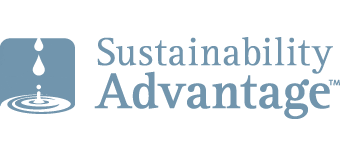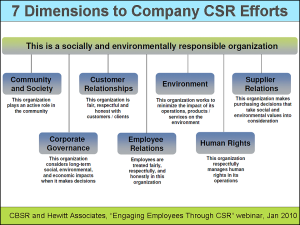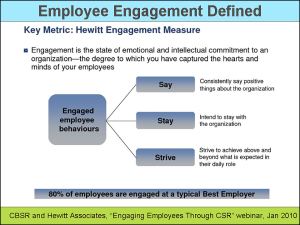CSR Efforts Correlate with Employee Engagement

“People buy from people they trust.” That was a slogan we used in sales training at IBM. We used it to reinforce the human element of a customer-supplier transaction. No trust, no sale. There’s a similar dynamic in the relationship between employees and their companies.
If employees’ values resonate with their company’s values, and if they trust that their company genuinely cares about the same things they care about, then they are more energized and productive. A company’s corporate social responsibility (CSR) efforts signal what it cares about. Their co-benefit is that they seem to increase employee engagement.
In my September 28, 2010, blog, I introduced a sustainability-enabled business value chain, shown in the adjacent slide. The blue sustainability strategies strengthen the links in the generic business value chain. Last week, in my October 5, 2010, blog, we zeroed-in on the connection between the “Engage employees in CSR programs” strategy and how doing so energizes the “Employee Engagement, Productivity, and Innovation” link.
This week, we will explore those linkages further.
Have a good suite of worthy CSR programsIf a company wants its employees to applaud its CSR programs, it needs to have a good variety of dimensions to those programs. Hewitt Associates, the global human resources consulting and outsourcing company that conducts the Best Employers in Canada study each year, suggests CSR programs should encompass the seven dimensions in the adjacent slide.
The corporate governance (1) and employee relations (2) factors both cover how the company treats its employees. The company’s relationship with its customers (3) and suppliers (4), including human rights (5), are also included. The ones that provide the best opportunity for employee volunteerism are the programs that address the company’s impacts on the environment (6) and on the community / society (7). This is a wonderfully holistic template for corporate CSR programs. It shows that there’s no magic, silver bullet; and that companies must avoid “green-washing” in all seven areas to be deemed a good corporate citizen by its own employees.
Have metrics for employee engagementIf we are to assess the correlation between employees’ engagement and their perception of the company’s CSR programs, we need to know how we would recognize an engaged employee if we saw one. Again, Hewitt Associates provides a helpful definition, as shown in the adjacent slide:
“Capturing the hearts and minds of employees” is the holy grail of managers and human resources professionals. The “Say” behavior helps to attract top talent to the organization through word-of-mouth; the “Stay” behavior mitigates attrition of top talent who are already working in the company; and the “Strive” behavior augments engagement and productivity as employees “strive to achieve above and beyond what is expected in their daily lives.” It’s the “Strive” / engagement behavior that interests us today.
As referenced in my October 5, 2010, blog, Hewitt Associates partnered with Canadian Business for Social Responsibility (CBSR) to understand the relationships between employees’ perceptions of their companies’ CSR efforts, their engagement, and other work-environment factors. Building on data from Hewitt Associates Best Employers in Canada studies, Hewitt and CBSR gathered opinions from over
100,000 employees and 2,000 leaders from more than 230 workplaces. I love the above chart from their study. This straight-line correlation shows that the more employees agree that their company is proactively pursuing worthy environmental and social activities, the more they are engaged. Intuitively, we might have suspected that. Happily, the study supports our intuition.
The study reinforces the connection between the “Engage employees in CSR programs” strategy and how it energizes the “Employee Engagement, Productivity, and Innovation” link. It’s hard to prove a cause-and-effect relationship; but at a minimum, it’s a happy correlation. A good CSR reputation is one of 21 factors that Hewitt has identified which correlate positively with employee engagement. They found that if a company reduces its focus on its CSR programs, employee engagement tends to fall off. So, if CEOs want to maintain or improve the level of their employees’ engagement, and strengthen the path to better business results, they might pay more attention to their CSR initiatives.
It also turns out that giving employees a chance to personally participate in the company’s CSR programs further invigorates their level of engagement. I will explore that connection next week.
Bob
The PowerPoint slides used above are from my Master Slide Set.
Please feel free to add your comments and questions using the Comment link below.








Comments are closed.